WHAT'S NEW ACROSS THE WORLD
| What's New ©by
Laif DeMason
Summer is upon us and interest in cichlid keeping
is still strong. Over the last few months, several regional cichlid meetings
have had good attendance, with more local hobbyists proving their interest.
Many hobbyists belong to local cichlid club Internet “chat rooms” and are
active in this manner. Some of the “old timer” cichlid hobbyists are accepting
speaking invitations, helping to stimulate the hobby with new information
from different speakers. However, almost all hobbyists have had some interesting
experiences or observations. The most important thing is to record these
observations — all fish keepers can write articles! Sit down and let us
know what and how your fish keep you interested. Give it a try, it’s part
of cichlid enjoyment!
Here’s “what’s new” on the cichlid scene: |
Lake Tanganyika
Interest in Tanganyika fishes seems to be stronger over the recent several
months. Collections from all around Lake Tanganyika are currently
taking place. Most all of the Congo shoreline (including the northern
section) is now being collected, making fish from all the lake regions
once again accessible to hobbyists; the last time this situation occurred
was over a decade ago! Congo exports are currently being funneled
through both Zambia and Tanzania, along with their own national varieties.
|
what's new: Lake Tanganyika
|

Reportedly from southern Congo, Neolamprologus
leleupi “black chin” lacks the solid orange coloration, but is an interesting
new variety. |

Caught in eastern Zambia, Julidochromis marlieri
Katoto is the most southerly occurring form of this species. |

Also hailing from southern Congo, Eretmodus cyanostictus
Kapampa sports blue points and partial yellow bars. |
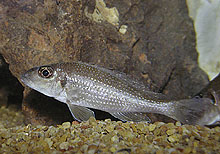
Exported from central Tanzania, Xenotilapis spilopterus
Magambo possesses shiny points covering its body. |

Found in many places in Zambia, Callochromis macrops
Chisanse males develop a very nice dark dress with light chin spotting
while breeding. |
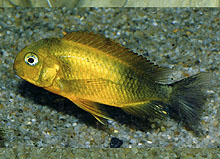
Developed in Burundi from a genetic morph, Tropheus
sp. “Kaiser gold” sports a nearly solid gold coloration, unlike the Kiriza
Kaiser variety. Photo by M. Lillie. |
Lake Malawi
Wild collections from most of the areas around Lake Malawi are stable
and fairly brisk. Some newer collectors are doubling their efforts
in the region, casting doubts as to whether or not there is a great enough
demand worldwide to actually support the increased harvesting. With
traditional methods being used by more divers, exporters are forced to
move into areas where fewer fishes can be harvested by hand, thus rendering
more effort per catch. Economic profitability will certainly move
some exporters to the sidelines, as we have seen in the past. Bred
items from elsewhere are still in good supply.

Many of the smaller Cynotilapia varieties are
very popular; here, C. axelrodi is one such species sought by small
mbuna fans. Photo A. Konings. |
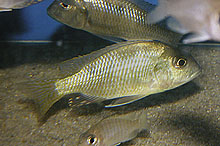
Occasionally exported from Tanzania, Tramitichromis
intermedius is sporadically available. |

Found sporadically in the extreme northern sections
of Malawi, Placidochromis phenochilus Mdoka is sought by some collectors. |
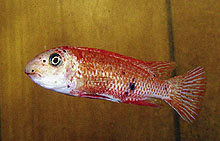
Selectively bred from the “opal” variety, this male
Labeotropheus trewavasae can exhibit strong red markings when fed
rich color foods. |
Lake Victoria / Madagascar
There is no change in the status of availability for Lake Victoria basin
fishes. The best sources are still specialty breeders, and the same is
true for Madagascar cichlids. Care must be taken as some buyers have reported
that some Victorian fish (or, worse, unidentifiable fish) are being sold
under incorrect names. It is important to ask to compare fish to photos
from known sources before purchases. Old issues of Cichlid News magazines
may be of help here. Buyers must beware!

Available from breeders, “Haplochromis” nyererei
red head from Zue Island, Tanzania. Photo by O. Seehausen. |

Originally from Madagascar and in demand by some hobbyists,
the Madagascan Paratilapia sp. “small spot” is often sold as P.
polleni from bred sources. |
West Africa
The rainy season has begun in most countries of West Africa, making
collection and, thus, exports fewer. Still, there is interest in these
cichlids and more information is now available to hobbyists who want to
try their hands at these newer varieties.

One of the more colorful chromidotilapiines, Chromidotilapia
guntheri loennbergii is collected in and around Lake Barombi-ba-Kotto
in Cameroon. Photo by A. Bornstein. |

Collected seasonally in Cameroon, Benitochromis
batesi Ntem, or “red fin,” is recognized by the red dorsal fin margin.
Photo by O. Lucanus. |
Neotropics
Seasonal changes in South American countries affect availability.
The rains have begun, and export selection had decreased. Tank-raised
items from breeders that specialize in Neotropical cichlids are often sold
through the normal importers and wholesalers of these fishes, generating
a greater number of choices. Even wider selections of discus fish
are being offered from the Far East. No telling if this means that
strain names will ever “standardize” in the near future.
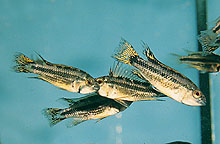
Many varieties of Apistogramma cacatuoides
are being bred, this one exhibits a contrasting black and white body coloration. |
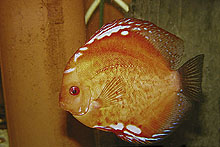
One of the many forms of the pigeon blood strain of
Symphysodon discus, sporting a solid body coloration with few white
spots. |
|















